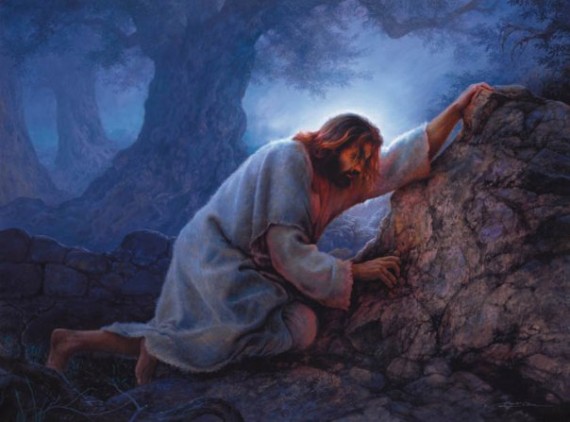One of our deepest desires is to draw nearer to God in prayer. We often do not know how to pray in a way that pleases God. Nothing could be more in line with the will of God than the seminal work of Christ in the gospel cycle. Therefore, the gospel cycle provides a pattern by which the disciple can gain confidence in prayer. Wherever we find ourselves in the gospel process, we can align our prayers with God’s purpose in that stage. This helps us know how to pray in His will both for ourselves and for others we love. It even helps us know how to pray for those we don’t know, or find it hard to love!
How do we know what to pray at the different way-points along the Jesus way? The best place to begin is with the prayers of Jesus as He fulfilled His mission.
Prayers of surrender. In His surrender in Gethsemane, Jesus labored in prayer  literally for hours, repeatedly wrestling with the Father until He could honestly pray, “nevertheless, not as I will, but as You will†(Matthew 26:36). It is bold to say but nonetheless true: Every work which God wants to do in your life must begin with your surrender. It is always His will for you to surrender to Him, no matter what the need or problem is. Surrender always opens the gospel cycle, and without it the further unfolding of the pattern will be inhibited. As you intercede for others, you will be surprised at how frequently the true need in their situation is to surrender in a new and deeper way to God. You cannot make another person surrender to God’s will, but you can fervently ask the Spirit of God to do that work in the one you care about.
literally for hours, repeatedly wrestling with the Father until He could honestly pray, “nevertheless, not as I will, but as You will†(Matthew 26:36). It is bold to say but nonetheless true: Every work which God wants to do in your life must begin with your surrender. It is always His will for you to surrender to Him, no matter what the need or problem is. Surrender always opens the gospel cycle, and without it the further unfolding of the pattern will be inhibited. As you intercede for others, you will be surprised at how frequently the true need in their situation is to surrender in a new and deeper way to God. You cannot make another person surrender to God’s will, but you can fervently ask the Spirit of God to do that work in the one you care about.
Prayers of sacrifice.  Jesus must not have ceased praying as He endured Golgotha! We have just a few specific prayers recorded from what must have been a continual calling out to the Father for strength. The essence of Jesus’ prayers helps us in praying through seasons when life demands extreme sacrifices.â€My God, My God, why have You forsaken Me†(Matt. 27:46b). In a sense this is one prayer that only Jesus could pray, for His sin-bearing demanded temporary separation from holy God (2 Cor. 5:21. Yet in a lesser way, we may experience darkness of soul that makes this kind of prayer appropriate.
Jesus also prayed from the cross, “Father, forgive them, for they do not know what they do†(Luke 23:34). In praying for ourselves and others, as we proceed through days of great sacrifice, it is always in the will of God for us to plead for grace toward others. Even where the offender does know what he is doing, our calling is to extend grace.
The core of praying in times of sacrifice is encapsulated in Jesus’ prayer, “Father, ‘into Your hands I commit My spirit’†(Luke 23:46). When God has asked you to give up something or someone dear, your ultimate prayer is to fully entrust all that you are to Him. This essence of true sacrifice is the most demanding, yet most liberating posture possible to any disciple.
Prayers of abiding.  Your seasons in the tomb may be devoid of prayer. Grief, delay, sadness, and confusion may make it impossible to pray. Others for whom you pray may be unable to pray for themselves such that your intercession is a great way to come alongside them. It is important that you not pressure another to pray when in fact God may have drawn them into a season of quietly abiding.
Burial-like seasons may afford you extended times of solitude and silence in which you need not make any effort to express your thoughts to God. In such times, prayer consists of waiting, listening, and even wondering.
Prayers of abiding may follow after times of pruning. God may have cleared away extraneous attachments in order to produce more fruit (Jn. 15:1-3). As a result, extended times when you are aware of abiding in Christ can produce prayers of hope. You may pray for fruitfulness to come, not only as you emerge from seasons in the tomb but even for the sweet fruit of mourning. This fruit is the kind offered by the woman who anointed Jesus with fragrant oil the night before His death (Mk. 14:3-9). He was pleased with her sensitivity to His impending death and burial.
Prayers of manifestation.  To put it mildly, Jesus was oriented to action after His resurrection. He told the women, “Do not be afraid. Go and tell My brethren to go to Galilee, and there they will see Meâ€(Matt. 28:10). That was not a prayer to God, but it shows that Jesus intended to show His disciples that He was alive. “Go therefore and make disciples of all the nations….†(Matt. 28:19a). Jesus wants to be known and seen!
Whatever surrender, sacrifice and burial have demanded now becomes the substance for resurrection prayer. Pray for the joy of Christ to emerge out from the sadness and loss. Pray for the healing of Christ to replenish that which was ill. Pray for the power of Christ to dispel weakness, fear, and doubt. In essence, pray for Jesus to show up in the situation in the miraculous way that only He can.
Back to index
 Fractals are prolific in the natural world which God created. Some of the fractal images reveal repeated patterns in, for example, the structure of leaves, vegetables and fruit. Take a look from the heavens and you will see fractals in cloud formations, and rivers carved in hillsides by rain. Observe the fractals in underwater coral and plant life. All of these and many more show the repeated pattern of growth set in place by God. See my former post called The Gospel Fractal here.
Fractals are prolific in the natural world which God created. Some of the fractal images reveal repeated patterns in, for example, the structure of leaves, vegetables and fruit. Take a look from the heavens and you will see fractals in cloud formations, and rivers carved in hillsides by rain. Observe the fractals in underwater coral and plant life. All of these and many more show the repeated pattern of growth set in place by God. See my former post called The Gospel Fractal here.



